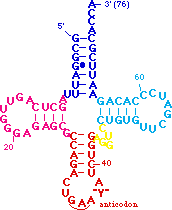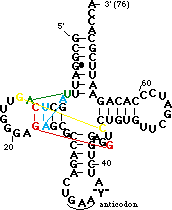Transfer RNA tour
From Proteopedia
(Difference between revisions)
(Undo revision 2576939 by James Nolan (Talk)) |
|||
| Line 10: | Line 10: | ||
the <B><FONT COLOR="#ff0000">anticodon</FONT></B> when charging tRNAs. <scene name='72/725890/Trna_overview/2'>Note how far the 3' end is</scene> from the <B><FONT COLOR="#ff0000">anticodon loop</FONT></B>, at bottom, by clicking here. Note also how the <B><FONT COLOR="#0000ff">acceptor stem</FONT></B> stacks onto the <B><FONT COLOR="#008aff">TpsiC stem</FONT></B> to form a continuous helix. The <B><FONT COLOR="#ff0000">anticodon stem</FONT></B> also stacks onto the junction between the <B><FONT COLOR="#aaaa00">variable loop</FONT></B> and the <B><FONT COLOR="#ff00ff">D stem</FONT></B> to form another nearly perfect helix. The <B><FONT COLOR="#008aff">TpsiC</FONT></B> and <B><FONT COLOR="#ff00ff">D loops</FONT></B> interact to bring the "cloverleaf" secondary structure in to the L-shaped tertiary structure. | the <B><FONT COLOR="#ff0000">anticodon</FONT></B> when charging tRNAs. <scene name='72/725890/Trna_overview/2'>Note how far the 3' end is</scene> from the <B><FONT COLOR="#ff0000">anticodon loop</FONT></B>, at bottom, by clicking here. Note also how the <B><FONT COLOR="#0000ff">acceptor stem</FONT></B> stacks onto the <B><FONT COLOR="#008aff">TpsiC stem</FONT></B> to form a continuous helix. The <B><FONT COLOR="#ff0000">anticodon stem</FONT></B> also stacks onto the junction between the <B><FONT COLOR="#aaaa00">variable loop</FONT></B> and the <B><FONT COLOR="#ff00ff">D stem</FONT></B> to form another nearly perfect helix. The <B><FONT COLOR="#008aff">TpsiC</FONT></B> and <B><FONT COLOR="#ff00ff">D loops</FONT></B> interact to bring the "cloverleaf" secondary structure in to the L-shaped tertiary structure. | ||
===Core Tertiary Interactions=== | ===Core Tertiary Interactions=== | ||
| - | Now <scene name='72/725890/Trna_tert_interact/ | + | Now <scene name='72/725890/Trna_tert_interact/6'> highlight the tertiary interactions</scene>. |
Most of the backbone is shown in ribbon format, with the same color scheme as above. Several unusual base pairs, base triples and turns are highlighted and color-coded. | Most of the backbone is shown in ribbon format, with the same color scheme as above. Several unusual base pairs, base triples and turns are highlighted and color-coded. | ||
[[Image:JnTerts.GIF]] | [[Image:JnTerts.GIF]] | ||
| - | <scene name='72/725890/Trna_tert_interact/ | + | <scene name='72/725890/Trna_tert_interact/5'>You can zoom in for a closer look</scene>. The yellow residues are a parallel base pair (compared to the normal anti parallel) between <B><FONT COLOR="#aaaa00">G15</FONT></B> of the <B>D-loop</B> and <B><FONT COLOR="#aaaa00">C48</FONT></B> of the <B>variable loop</B>. This brings the <B>D-loop</B> and <B>variable loop</B> together. Note the sharp turn in the backbone between <B><FONT COLOR="#aaaa00">C48</FONT></B> and <B><FONT COLOR="#aaaa00">C49</FONT></B> caused by the parallel pair. |
The green residues are a reverse Hoogsteen pair between <B><FONT COLOR="#00bf00">U8</FONT></B> and <B><FONT COLOR="#00bf00">A14</FONT></B>. This pairing is important for positioning of the <B>D stem</B> relative to the stacked <B>T</B> and <B>acceptor</B> stems. | The green residues are a reverse Hoogsteen pair between <B><FONT COLOR="#00bf00">U8</FONT></B> and <B><FONT COLOR="#00bf00">A14</FONT></B>. This pairing is important for positioning of the <B>D stem</B> relative to the stacked <B>T</B> and <B>acceptor</B> stems. | ||
Revision as of 22:03, 27 February 2016
A-form RNA
| |||||||||||


